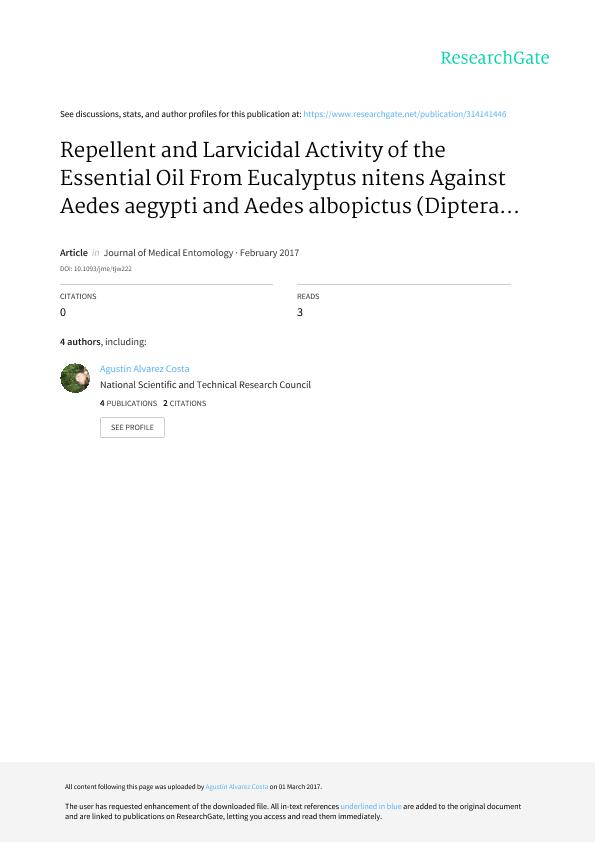Artículo
Repellent and Larvicidal Activity of the Essential Oil From Eucalyptus nitens Against Aedes aegypti and Aedes albopictus (Diptera: Culicidae)
Fecha de publicación:
01/2017
Editorial:
Entomological Society of America
Revista:
Journal of Medical Entomology
ISSN:
0022-2585
Idioma:
Inglés
Tipo de recurso:
Artículo publicado
Clasificación temática:
Resumen
Dengue, chikungunya, and yellow fever are important vector-borne diseases transmitted by female mosquitoes when they feed on humans. The use of repellents based on natural products is an alternative for personal protection against these diseases. Application of chemicals with larvicidal activity is another strategy for controlling the mosquito population. The repellent and larvicidal activities of the essential oil from Eucalyptus nitens were tested against Aedes aegypti and Aedes albopictus, the main vectors of these arboviruses. The essential oil was extracted by hydrodistillation and then analyzed by gas chromatography–mass spectrometry. The main components of Eucalyptus nitens essential oil were found to be terpenes such as 1,8-cineole and p-cymene, followed by β-triketones and alkyl esters. The repellent activity of the essential oil against both species was significantly higher when compared with the main component, 1,8-cineole, alone. These results indicate that the repellent effect of E. nitens is not due only to the main component, 1,8-cineole, but also that other compounds may be responsible. Aedes aegypti was found to be more tolerant to the essential oil larvicidal effects than Ae. albopictus (Ae. aegypti LC50 = 52.83 ppm, Ae. albopictus LC 50 = 28.19 ppm). The repellent and larvicidal activity could be associated to the presence of cyclic β-triketones such as flavesone, leptospermone, and isoleptospermone.
Palabras clave:
Eucalyptus Nitens
,
Repellent
,
Larvicidal
,
Aedes Aegypti
Archivos asociados
Licencia
Identificadores
Colecciones
Articulos(UNIDEF)
Articulos de UNIDAD DE INVESTIGACION Y DESARROLLO ESTRATEGICOS PARA LA DEFENSA
Articulos de UNIDAD DE INVESTIGACION Y DESARROLLO ESTRATEGICOS PARA LA DEFENSA
Citación
Alvarez Costa, Agustin; Naspi, Cecilia Veronica; Lucia, Alejandro; Masuh, Hector Mario; Repellent and Larvicidal Activity of the Essential Oil From Eucalyptus nitens Against Aedes aegypti and Aedes albopictus (Diptera: Culicidae); Entomological Society of America; Journal of Medical Entomology; 54; 0; 1-2017; 670-676
Compartir
Altmétricas




